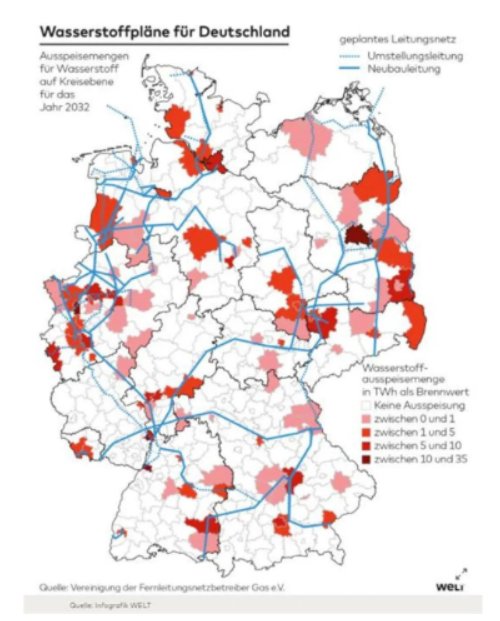According to the new plans of the German government, hydrogen energy will play a role in all important fields in the future. The new strategy outlines an action plan to ensure market building by 2030.
The previous German government had already presented the first version of the national hydrogen energy strategy in 2020. The traffic light government now hopes to speed up the promotion of the national hydrogen energy network construction and ensure that sufficient hydrogen energy will be obtained in the future under the condition of import supplementation. Electrolysis capacity for hydrogen generation will increase from 5 GW to at least 10 GW by 2030.
As Germany is far from being able to produce enough hydrogen itself, a further import and storage strategy will be pursued. The first version of the national strategy states that by 2027 and 2028, an initial network of more than 1,800 kilometers of retrofitted and newly built hydrogen pipelines should be created.
The lines will be partly supported by the Projects of Important European Common Interest (IPCEI) program and embedded in a trans-European hydrogen grid of up to 4,500 km. All major generation, import and storage centers should be connected to relevant customers by 2030, and hydrogen and its derivatives will be used in particular in industrial applications, heavy commercial vehicles and increasingly in aviation and shipping.
In order to ensure that hydrogen can be transported over long distances, the 12 major pipeline operators in Germany also introduced the planned “National Hydrogen Energy Core Network” joint plan on July 12. “Our goal is to retrofit as much as possible and not to build new,” said Barbara Fischer, president of Germany’s transmission system operator FNB. In the future, more than half of the pipelines for transporting hydrogen will be transformed from the current natural gas pipelines.
According to current plans, the network will include pipelines with a total length of 11,200 kilometers and is scheduled to be operational in 2032. FNB estimates the cost will be in the billions of euros. The German Federal Ministry of Economic Affairs uses the term “hydrogen highway” to describe the planned pipeline network. The German Federal Ministry of Energy said: “The hydrogen energy core network will cover the currently known large hydrogen consumption and production regions in Germany, thus connecting central locations such as large industrial centers, storage facilities, power plants and import corridors.”
In an as-yet-unplanned second phase, from which more and more local distribution networks will branch out in the future, a comprehensive hydrogen network development plan will be included in the Energy Industry Act by the end of this year.
As the hydrogen network is largely filled by imports, the German government is already in talks with several large foreign hydrogen suppliers. Large quantities of hydrogen are likely to be transported through pipelines in Norway and the Netherlands. Green energy hub Wilhelmshaven is already building large infrastructure projects for the transport of hydrogen derivatives such as ammonia by ship.
Experts are skeptical that there will be enough hydrogen for multiple uses. In the pipeline operator industry, however, there is optimism: Once the infrastructure is in place, it will also attract producers.
Post time: Jul-24-2023









